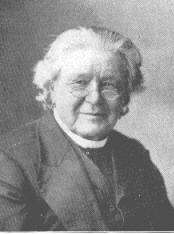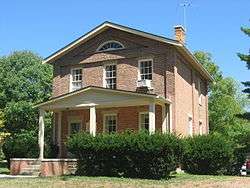L. L. Langstroth
Rev. Lorenzo Lorraine Langstroth (December 25, 1810 – October 6, 1895) was an American apiarist, clergyman and teacher, and considered to be the father of American beekeeping. He created the modern day Langstroth hive.[1]
Lorenzo Langstroth | |
|---|---|
 | |
| Born | December 25, 1810 Philadelphia, Pennsylvania |
| Died | October 6, 1895 |
| Nationality | American |
| Alma mater | Yale University (1831) |
| Occupation | 5th Pastor of the South Church, Andover, Massachusetts Beekeeper |
Notable work | Inventor of the Langstroth hive Father of American beekeeping |
| Spouse(s) | Anne Tucker (1812–1873) |
| Children | James Langstroth (1837) Anna Langstroth (1840) Harriet A. Langstroth (1847) |
Early life and family
Langstroth was born in Philadelphia, Pennsylvania Christmas day, 1810. He graduated from Yale University in 1831, and subsequently held a tutorship there in 1834-1835. After this he was pastor of various Congregational churches in Massachusetts, including the South Church in Andover, Massachusetts in May 1836. From 1843-48 he served as pastor of Second Congregational Church in Greenfield, Massachusetts A large granite marker was placed on the church's front lawn by national beekeeper E.F. Phillips and others in 1948. In 1848, Langstroth became principal of a young ladies' school in Greenfield, Massachusetts.
Contributions to beekeeping
The Leaf Hive, invented in Switzerland in 1789 by François Huber, was a fully movable frame hive, but had solid frames that were touching and made up the "box". The combs in this hive were examined like pages in a book. Langstroth acknowledged Huber's contribution: "The use of the Huber hive had satisfied me that, with proper precautions, the combs might be removed without enraging the bees, and that these insects were capable of being tamed to a surprising degree. Without knowledge of these facts, I should have regarded a hive permitting the removal of the combs as quite too dangerous for practical use." (Langstroth on the Honey-Bee, 1860)
Development of the bee space
Langstroth was popularly credited with discovering the "bee space," though this discovery had already been implemented in European hives. In Europe, both Jan Dzierżon and August von Berlepsch had been focused on side-opened hives. Land resources in Europe had been limited, and traditionally bees were kept in beehouses. The presently so-called “bee space” had been incorporated by Berlepsch following Dzierzon’s discoveries, from the years 1835–1848, into his frame arrangement (Bienen-Zeitung, May 1852). Langstroth made many other discoveries in beekeeping and contributed greatly to the industrialization of modern beekeeping.
Langstroth revolutionized the beekeeping industry by using bee space in his top-opening hive. In the summer of 1851 he found that, by leaving an even, approximately bee-sized space between the top of the frames holding the honeycomb and the flat coverboard above, he was able quite easily to remove the coverboard, which was normally well cemented to the frames with propolis, making separation hard to achieve. He later used this discovery to make the frames themselves easily removable. If a small space was left (less than 1/4 inch or 6.4 mm) the bees filled it with propolis; on the other hand, when a larger space was left (more than 3/8 inch or 9.5 mm) the bees filled it with comb.
Innovations to beehive design
On 5 October 1852, Langstroth received a patent on the first movable frame beehive in America. A Philadelphia cabinetmaker, Henry Bourquin, a fellow bee enthusiast, made Langstroth's first hives for him and by 1852 Langstroth had more than a hundred of these hives and began selling them where he could. Langstroth spent many years attempting to defend his patent without success. He never earned any royalties because the patent was easily and widely infringed. Langstroth hives are still in common use today. He wrote that "... the chief peculiarity in my hive was the facility with which they could be removed without enraging the bees .... I could dispense with natural swarming, and yet multiply colonies with greater rapidity and certainty than by the common methods .... feeble colonies could be strengthened, and those which had lost their queen furnished with the means of obtaining another. .... If I suspected that anything was wrong with a hive, I could quickly ascertain its true condition and apply the proper remedies."
Langstroth also found that several communicating hive boxes can be stacked one above another and that the queen can be confined to the lowest, or brood, chamber, by means of a queen excluder. In this way, the upper chambers can be reached only by the workers and therefore contain only honey-comb. This made hive inspection and many other management practices possible and turned the art of beekeeping into a full-scale industry. At the time of Langstroth's contributions, honey was the chief sweetener in American diets, so Langstroth's new beekeeping techniques were of great importance. His discoveries and inventions allowed beekeeping to be done more cost-effectively on a large scale. Since four to twelve pounds of honey, and many hours of bee time, are consumed by bees in the production of one pound of beeswax, honey production was increased from reuse of the comb.
The Hive and the Honey-Bee
In 1853, Langstroth had moved back to Greenfield, Massachusetts from Philadelphia and published The Hive and the Honey-Bee (Northampton (Massachusetts): Hopkins, Bridgman, 1853), which provided practical advice on bee management and, after more than 40 editions, is still in print today. Langstroth on the Honey Bee was published in 1860.
Move to Oxford, Ohio

After 1858 Langstroth made Oxford, Ohio, his residence, and devoted his time to beekeeping. The site was 10 acres (40,000 m2) and was an ideal place to keep bees. Langstroth planted a row of linden trees along the street and apple trees throughout his property. He sowed buckwheat and clover seed, using 1-acre (4,000 m2) of ground for a formal garden, filled with the flowers that bees like best, calling it his honey garden. The home where he lived from 1858 to 1887 was built in 1856 and is now called Langstroth Cottage; it is designated a National Historic Landmark. It was donated to Western College for Women and is today home to the Miami University Center for the Enhancement of Learning and Teaching.
Langstroth received his first Italian bees at his home in 1863; Italian bees were more productive than the European bees that were most common in America at the time. He and his son sold Italian queens at 20 dollars each and in one year sold 100 of them, many being sent by post all over the United States.
Later life
In 1887, he moved with his daughter, Mrs. H. C. Cowan, and her family to Dayton, Ohio. Langstroth died in the pulpit of the Wayne Avenue Presbyterian Church in Dayton on October 6, 1895, just as he was beginning a sermon on the love of God. He is buried at Woodland Cemetery and Arboretum in Dayton. His epitaph reads as follows:[2]
Inscribed to the memory of Rev. L.L Langstroth, "Father of American beekeeping," by his affectionate beneficiaries who, in the remembrance of the service rendered by his persistent and painstaking observations and experiments with the honey bee, his improvements in the hive, and the literary ability shown in the first scientific and popular book on the subject of beekeeping in the United States, gratefully erect this monument.
Langstroth's papers are located at the American Philosophical Society Library in Philadelphia.
Patents
- USPatent|9300—L.L. Langstroth's patent for a Bee hive from Oct. 5, 1852
- USPatent|RE1484—L.L. Langstroth's patent for a Bee hive Reissued from May 26, 1863
- USPatent|61216-L.L. Langstroth's joint patent (with S. Wagner) for an Improved Apparatus for Extracting Honey from the Comb from January 15, 1867
See also
- Clyde Cowan – his great-grandson, astrophysicist, and co-discoverer of the neutrino.
- Langstroth's Hive and the Honey-Bee, Dover Publications ISBN 0-486-43384-6 (original version, still in print)
- Ron Brown's Great Masters of Beekeeping, Bee Books New and Old ISBN 0-905652-31-2
- Apiology
References
- US Patent US9300A - October 5, 1852
- "Lorenzo L Langstroth". americasbeekeeper.org. Retrieved 2016-05-05.
External links
| Wikimedia Commons has media related to Lorenzo Lorraine Langstroth. |
- Works by L. L. Langstroth at Project Gutenberg
- Works by or about L. L. Langstroth at Internet Archive
- Works by L. L. Langstroth at LibriVox (public domain audiobooks)

- Scan of "Langstroth on the hive and the honey-bee" 1853 edition
- L. L. (Lorenzo Lorraine) Langstroth papers at the American Philosophical Society
- L. L. Langstroth at Find a Grave